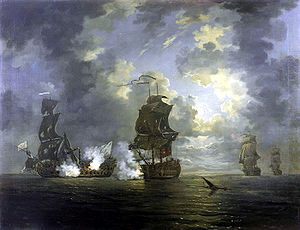HMS Foudroyant (1758)
 Capture of the Foudroyant by the British Monmouth, 28 February 1758 | |
| Career (France) | |
|---|---|
| Name: | Foudroyant |
| Builder: | Toulon shipyard |
| Laid down: | August 1748 |
| Launched: | 18 December 1750 |
| Commissioned: | April 1751 |
| Honours and awards: |
Participated in: |
| Captured: | 28 February 1758, by the Royal Navy |
| Career (Great Britain) | |
| Name: | HMS Foudroyant |
| Acquired: |
Captured on 28 February 1758 Purchased by Admiralty order on 6 December 1758 |
| Commissioned: | June 1759 |
| Honours and awards: |
Participated in: |
| Fate: | Broken up by 26 September 1787 |
| General characteristics [1] | |
| Class and type: | 80-gun Third Rate ship of the line |
| Tons burthen: | 1979 bm |
| Length: | 180 ft 5 in (54.99 m) (gundeck) |
| Beam: | 50 ft 3 in (15.32 m) |
| Depth of hold: | 23 ft (7.0 m) |
| Propulsion: | Sails |
| Sail plan: | Full rigged ship |
| Armament: |
80 guns:
|
The Foudroyant was a 80-gun ship of the line of the French Navy. She was later captured and served in the Royal Navy as the Third Rate HMS Foudroyant.[1]
Foudroyant was built at Toulon to a design by François Coulomb, and was launched on 18 December 1750.[2] She was present at the Battle of Minorca in 1756, where she engaged the British flagship HMS Ramillies. She then formed part of a squadron under Jean-François de La Clue-Sabran, during which time she was captured during the Battle of Cartagena off Cartagena, Spain[3] on 28 February 1758 by Monmouth, Hampton Court and Swiftsure.[4]
She was brought into Portsmouth and surveyed there in September 1758 for £163.10.2d. The Admiralty approved her purchase on 7 November that year, and she was duly bought on 6 December for the sum of £16,759.19.11d.[2] She was officially named Foudroyant and entered onto the navy lists on 13 December 1758. She underwent a refit at Portsmouth between February and August 1759 for the sum of £14,218.9.2d to fit her for navy service.[2]
She was commissioned in June 1759 under the command of Captain Richard Tyrell, serving as the flagship of Vice-Admiral Sir Charles Hardy between June and October 1759.[2] She spent August sailing with Admiral Edward Hawke's fleet. Foudroyant underwent another refit at Portsmouth in the spring of 1760, commissioning later that year under Captain Robert Duff. She sailed to the Leeward Islands in April 1760, but had returned to Britain by Autumn 1761 to undergo another refit. She took part in the operations off Martinique in early 1762, before coming under the command of Captain Molyneaux Shuldham later that year.[2] She served for a short period as the flagship of Admiral George Rodney, before being paid off in 1763. She underwent several surveys, and a large repair between February 1772 and January 1774, after which she was fitted to serve as the Plymouth guardship in April 1775. She recommissioned again in August that year, under the command of Captain John Jervis, and was stationed at Plymouth until early 1777.[2]
In March 1777 she was fitted for service in the English Channel, and spent that summer cruising off the French coast. On 18 June 1778 she engaged and captured the 32-gun Le Pallas, and was then present with Admiral Augustus Keppel's fleet at the Battle of Ushant on 27 July 1778.[2] Jervis was briefly replaced as captain by Captain Charles Hudson, while the Foudroyant became the flagship of her old commander, now Vice-Admiral Lord Shuldham.[2] Jervis resumed command in 1779, sailing with Hardy's fleet, before being moved to a detached squadron in December 1779. Foudroyant returned to port in early 1780, where she was refitted and had her hull coppered. On the completion of this work by May, she returned to sea, sailing at first with Admiral Francis Geary's fleet, and later with George Darby's. She was then present at the relief of Gibraltar in April 1781, after which she was moved to Robert Digby's squadron.[2] By the summer of 1781 she had returned to sailing with Darby's fleet, and by April 1782 had moved to a squadron under Samuel Barrington. She captured the French 74-gun Pégase on 21 April 1782, for which actions Jervis was knighted.[2] She sailed again in July 1782, this time as part of a fleet under Admiral Richard Howe, before spending the autumn cruising in the Western Approaches. She briefly came under the command of Captain William Cornwallis in 1783, but was soon paid off and then fitted for Ordinary.
Fate
An Admiralty order of 24 August 1787 provided for Foudroyant to be broken up and she was sold off for £479.3.2d. The breaking up had been completed by 26 September 1787.[2]
Notes
References
- Colledge, J. J.; Warlow, Ben (2006) [1969]. Ships of the Royal Navy: the complete record of all fighting ships of the Royal Navy (Rev. ed.). London: Chatham. ISBN 9781861762818. OCLC 67375475.
- Lavery, Brian (2003). The Ship of the Line - Volume 1: The development of the battlefleet 1650-1850. Conway Maritime Press. ISBN 0-85177-252-8.
- Winfield, Rif, British Warships of the Age of Sail 1714–1792: Design, Construction, Careers and Fates, pub Seaforth, 2007, ISBN 1-86176-295-X
